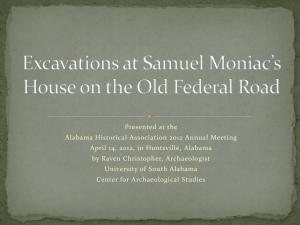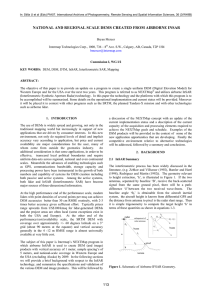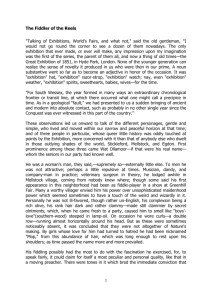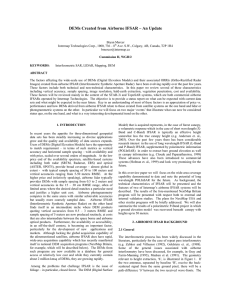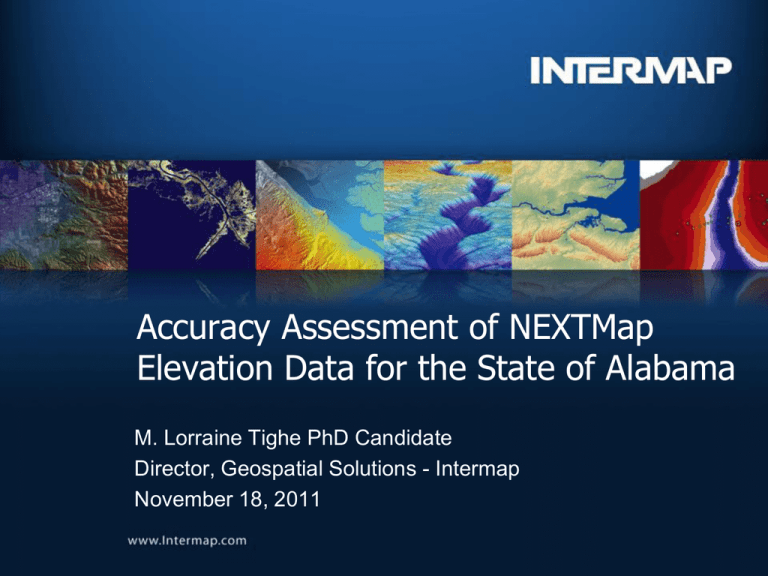
Accuracy Assessment of NEXTMap
Elevation Data for the State of Alabama
M. Lorraine Tighe PhD Candidate
Director, Geospatial Solutions - Intermap
November 18, 2011
Agenda
Introduction
Objectives
Study Area
Data
Analysis
Results
Discussion
Conclusions
2
Introduction
This paper presents the results of the vertical accuracy
of NEXTMap derived bare ground elevation data over a
variety of land cover types by comparing it against
National Geodetic Survey (NGS) reference points and
against the United States Geological Survey National
Elevation Data (NED) for the State of Alabama.
3
Objectives
Investigate the
accuracy of the
NEXTMap data for the
State of Alabama
against survey control
reference data (1126
available NGS) and 10
m NED data.
Investigate barren and
obstructed land cover
of all slopes.
4
Study Area
State of Alabama
Area: 52,419 mi2 (135,765 km2)
Elevation Range: sea level to 2,413 ft
(735.5 m)
Water Land Cover: 3.19% (1,672
km2)
Forest Land Cover: 67% 22 million ha
(89,000 km2)
5
Data
Elevation Data:
• 5 m NEXTMap DTM
• 10 m NED DTM
Reference Data:
• 1126 National
Geodetic Survey
(NGS) geodetic data
points
1126 NGS control points
6
Collection – to – End Product: NEXTMap
Collection
7
Production
© 2011 Intermap Technologies. All rights reserved.
Aggregation
Applications
Distribution
The Core Technology - IFSAR
Interferometric Synthetic Aperture Radar - IFSAR
Note: STAR-3i uses GPS ground station for
differential processing; no other ground control
points are required.
8
IFSAR Processor to Derive Height Measurements
The variation in phase difference from pixel to pixel can be converted into
relative change in surface elevation through a set of (closed form) equations to
yield x, y, and z.
B
A1
A2
a
r + dr
h
qf
r
beams
z(y)
y
9
Digital Surface Model (DSM)
DSM: Winston County, Alabama.
Confluence of Right Fork Clear Creek and
Clear Creek. Also showing US Highway 278.
10
Digital Terrain Model (DTM)
DTM: Winston County, Alabama. Confluence of
Right Fork Clear Creek and Clear Creek. Also
showing US Highway 278.
11
Handling Obstructed and Void Areas
The acquisition plan is
designed to minimize the
percent of void data in the
output product.
We have a fully integrated
terrain solution (FITS) that
can utilize modified DSM
data or ancillary data to fill
in voids and to help
recalculate the terrain
surface beneath vegetation
canopies.
e.g. Before the “Void
Infill” process has been
automatically run, void
areas have an interpolated
appearance
12
Terrain Solution
We use a modified version
of our multiple DSM passes
or ancillary data to rebuild
the DTM in areas of void
and obstruction.
We will use available
ancillary data as a last
resort.
e.g. After the “Void Infill”
process has been
automatically run, the
ancillary DEM has a more
natural appearance
13
Analysis
Visual assessments, in particular, drainage features were
conducted.
Statistical analysis (RMSE, mean error, standard
deviation, cumulative frequency plot) is implemented
with the use of the NGS geodetic data points to calculate
the vertical accuracy of the NEXTMap and NED data.
Data Characterizations: land cover analysis to
characterize where to expect the range of vertical
accuracies.
14
Visual Assessment Results
Intermap’s NEXTMap data for the State of Alabama is current, as a majority of the
state was collected with the same sensor between 2005 and 2008. By comparison,
a majority of the vintage NED that is available for the state was collected between
1960 and 1979. Portions of the NED were collected prior to 1959.
Different vintages and resolutions result in different drainage delineations.
15
Visual Assessment Results
NEXTMap
16
Statistical Results (1)
17
Land Cover
Slope
Barren
<10o
Vegetation
<10o
Dense
Vegetation
0o - 29o
Statistic (m)
Mean error
StDev
RMSE
Mean error
StDev
RMSE
Mean error
StDev
RMSE
NEXTMap
-0.19
0.51
0.55
-0.5
1.38
1.47
-0.74
2.59
2.99
NED
0.13
1.35
1.36
-0.27
1.53
1.56
-0.5
3.66
3.67
Statistical Results (2)
Cumulative percent error plot (Barren, low slopes)to help
to visualize what percentage of data can be expected to
meet various accuracies.DEMs vs. VCP
100
90
Cumulative Percentage
80
70
60
50
40
30
20
10
0
0
0.5
1
1.5
NED
18
2
2.5
3
3.5
4
4.5
SRTM_DT2
5
5.5
6
6.5
DTM
7
7.5
8
8.5
DSM
9
9.5
10
Alabama Data Characterization
A snapshot of the data
characterization of the State of
Alabama, with respect to the
accuracy to be expected by
NEXTMap data.
19
Conclusions
Vertical Accuracy Assessment (expressed in RMSE):
• 0.55 m in barren terrain
• 1.27 – 3 m in obstructed terrain (e.g. vegetation/urban)
Hydrological analysis:
• NEXTMap more accurate representation of water ways
(e.g. lakes, ponds, rivers, streams) than NED
• difference in DTM resolution: 5m NEXTMap, 10 m NED
• temporal differences: NEXTMap 2008; NED ~ 20 years
20
Thank You
QUESTIONS?
More information:
ltighe@intermap.com
kbarrett@intermap.cpm
www.intermap.com
21







